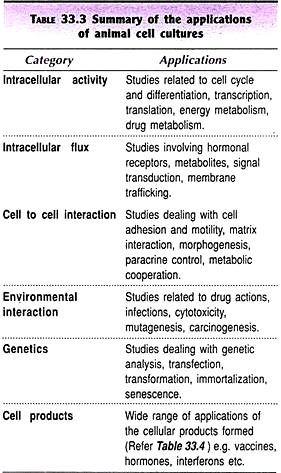Read this article to learn about the applications of animal cell cultures.
There is a widespread concern that extensive use of animals for laboratory experiments is not morally and ethically justifiable. Animal welfare group’s world over are increasingly criticising the use of animals. Some research workers these days prefer to utilize animal cell cultures wherever possible for various studies. The major applications of laboratory animal cell cultures are given in Table 33.3, and listed below.
i. Studies on intracellular activity e.g. cell cycle and differentiation, metabolisms.
ii. Elucidation of intracellular flux e.g. hormonal receptors, signal transduction.
iii. Studies related to cell to cell interaction e.g. cell adhesion and motility, metabolic cooperation.
iv. Evolution of environmental interactions e.g. cytotoxicity, mutagenesis.
v. Studies dealing with genetics e.g. genetic analysis, immortalization, senescence.
vi. Laboratory production of medical/pharmaceutical compounds for wide range of applications e.g. vaccines, interferon’s, hormones.
There are however, several limitations on the use of animal cell cultures. This is mostly due to the differences that exist between the in vivo and in vitro systems, and the validity of the studies conducted in the laboratory.
Medical / Pharmaceutical Products of Animal Cell Cultures:
The most important application of animal cell cultures is the production of a wide range of commercial compounds for medical and pharmaceutical use. A selected list of animal cell culture products of commercial importance is given in Table 33.4.
Production of vaccines:
Monkey kidney or chick embryo cells or recently human diploid cells are in use for the production of vaccines. The vaccine manufacture in animal cell cultures is rather complex with risk of contamination, and safety aspect. For these reasons, production of vaccines by recombinant DNA technology employing bacteria or yeasts is preferred.
Production of high value therapeutics:
Many human proteins with high therapeutic potential are often in short supply e.g. tissue plasminogen activator, clotting factors (VIII and IX), and erythropoietin. There is a major limitation to produce human proteins that undergo post- translational modifications (glycosylation, carboxylation etc.) in bacteria and yeasts.
This is due to the fact that these organisms do not possess the machinery to perform post-translational changes. However, pharmaceutical proteins that do not require post-translational modifications can be produced by bacteria or yeasts e.g. insulin, albumin, growth hormone. Animal cell cultures (particularly mammalian cell cultures) are useful for the production of many pharmaceutically/medically important proteins (Table 33.4).
These include the following:
i. Plasminogen
ii. Interferon
iii. Blood clotting factors
iv. Hormones
v. Monoclonal antibodies
vi. Erythropoietin.
Purification of pharmaceutical products:
As the desired product is produced in the cell culture medium, its purification, isolation and storage (collectively referred to as downstream processing) assumes significance. The final product for therapeutic applications is expected to satisfy the following criteria.
i. The product should have a stable structure with optimal activity.
ii. The product should be free from other biomolecules that may interfere with its activity and/or cause immunological complications.
iii. It should be free from all pathogens including viruses.
Genetic Engineering of Animal Cells and their Applications:
It is now possible to genetically modify the animal (mammalian) cells to introduce the genes needed for the production of a specific protein or improve the characteristics of a cell line.
The following methods are used to introduce foreign DNA into mammalian cells:
1. Electroporation
2. Lipofection
3. Microinjection
4. Fusion of mammalian cells with bacteria or viruses.
As the foreign DNA gets integrated into the mammalian cellular genome, the gene expresses to produce the desired protein. It is however, necessary to select the best producing recombinant cells by conventional methods using selectable marker genes.
The following selectable markers are used for choosing the transfected cells:
i. Viral thymidine kinase
ii. Bacterial dihydrofolate reductase
iii. Bacterial neomycin phosphotransferase
It has been possible to overproduce several proteins in mammalian cells through genetic manipulations e.g., tissue plasminogen activator, erythropoietin, interleukin-2, interferon-β, clotting factors VIII and IX, tumor necrosis factors. The recombinant mammalian cells are conveniently used for the production of monoclonal antibodies which have wide range of applications.

